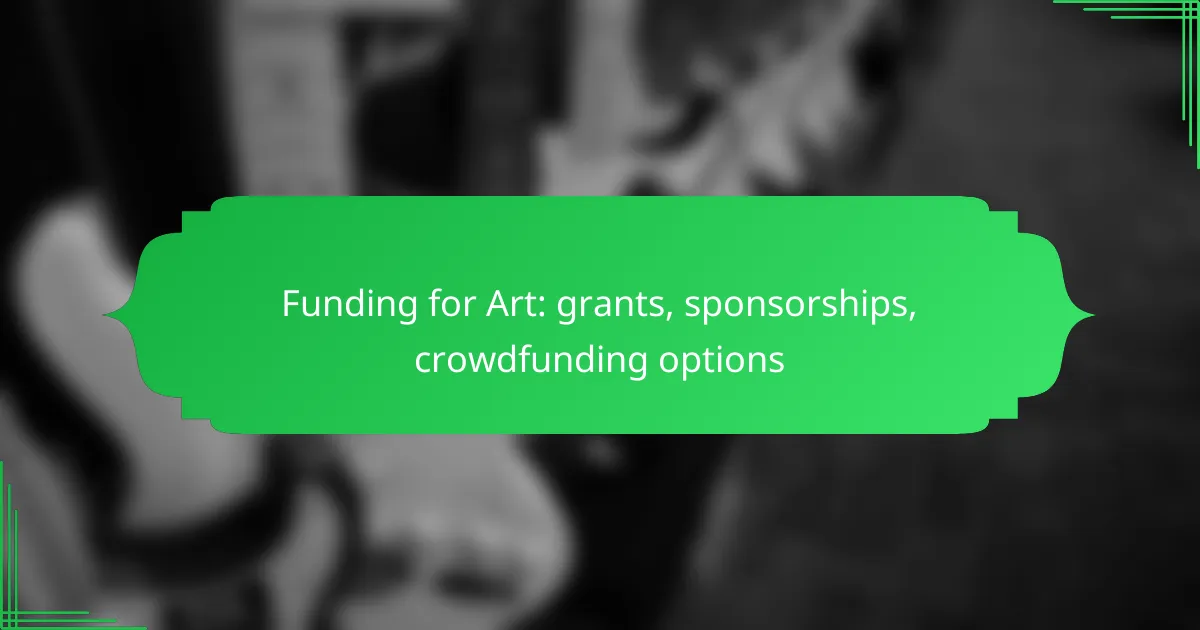Funding for art is crucial for artists looking to bring their creative visions to life, and there are various avenues available, including grants, sponsorships, and crowdfunding. Each option offers unique benefits and challenges, requiring artists to carefully consider their approach to secure the necessary financial support. By exploring local authority grants, aligning with potential sponsors, and utilizing specialized crowdfunding platforms, artists can effectively navigate the funding landscape to enhance their projects.
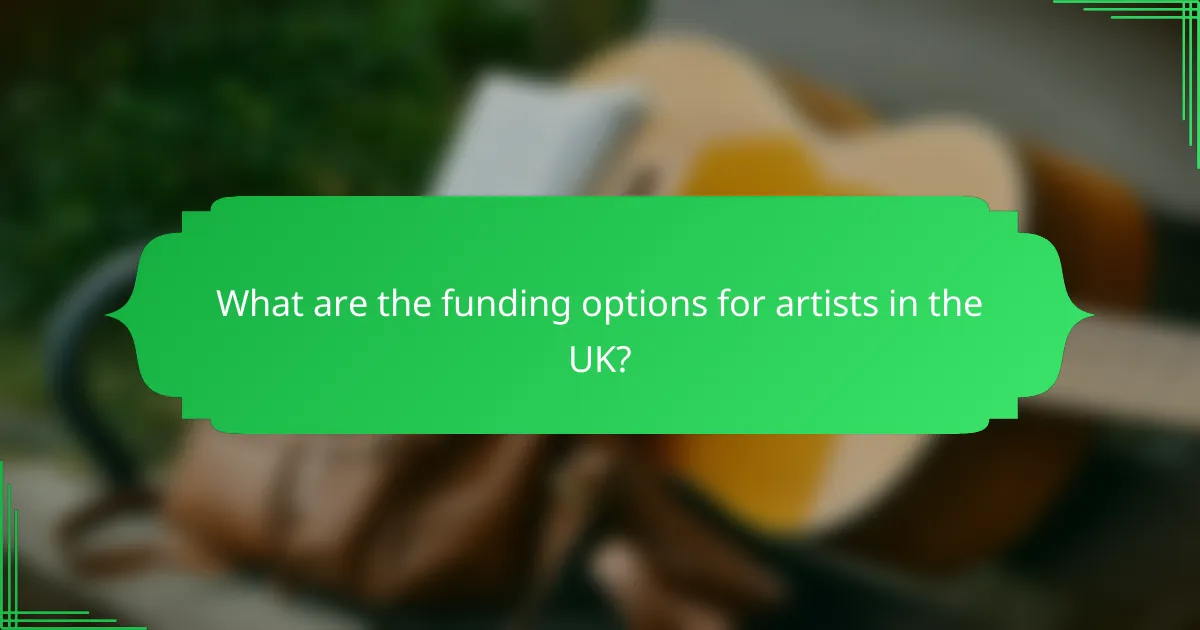
What are the funding options for artists in the UK?
Artists in the UK have several funding options, including grants, local authority support, and private foundation grants. Each option has unique criteria and application processes, making it essential for artists to explore all avenues to secure financial backing for their projects.
Grants from Arts Council England
Arts Council England provides a range of grants to support artists, museums, and libraries. These grants can fund projects that promote creativity and cultural engagement, with funding amounts varying widely based on the project’s scope and impact.
To apply, artists typically need to submit a detailed proposal outlining their project, budget, and expected outcomes. It’s crucial to align the project with the Arts Council’s priorities to enhance the chances of receiving funding.
Local authority funding
Local authorities in the UK often offer funding for arts initiatives that benefit the community. This funding can come in the form of grants, sponsorships, or partnerships, aimed at enhancing local culture and engagement.
Artists should check with their local council for specific opportunities, as each authority has different criteria and funding limits. Engaging with local arts officers can provide valuable insights into available resources and application processes.
Private foundation grants
Private foundations frequently offer grants to support individual artists or specific art projects. These grants can vary significantly in terms of eligibility, funding amounts, and application requirements.
Artists should research foundations that align with their artistic vision and values. Tailoring applications to reflect the foundation’s mission can improve the likelihood of securing funding. Networking and building relationships with foundation representatives can also be beneficial.

How can artists secure sponsorships in the UK?
Artists in the UK can secure sponsorships by identifying potential sponsors whose values align with their work and presenting compelling proposals. Building relationships and demonstrating the benefits of collaboration are key to successful sponsorship arrangements.
Corporate sponsorship opportunities
Corporate sponsorships can provide significant funding for art projects. Companies often seek to enhance their brand image and community engagement through partnerships with artists. To attract corporate sponsors, artists should research companies that have a history of supporting the arts and tailor their proposals to highlight mutual benefits.
Consider creating a sponsorship package that outlines the project, target audience, and potential exposure for the sponsor. This could include branding opportunities at events, social media mentions, and inclusion in promotional materials. Aim for clarity and professionalism in your presentation to make a strong impression.
Brand partnerships for art projects
Brand partnerships can be a fruitful avenue for artists looking to fund their projects. These collaborations often involve aligning with brands that resonate with the artist’s vision and audience. Brands may provide financial support, materials, or promotional assistance in exchange for visibility and association with the artistic endeavor.
When pursuing brand partnerships, focus on creating a win-win scenario. Clearly articulate how the partnership will enhance the brand’s image and reach. Examples include co-hosting events, creating limited edition products, or integrating brand messaging into the artwork itself. Always ensure that the partnership aligns with your artistic integrity and vision.

What are effective crowdfunding platforms for artists?
Effective crowdfunding platforms for artists include specialized sites that cater to creative projects, allowing artists to raise funds directly from supporters. These platforms provide a space for artists to showcase their work and connect with potential backers, making it easier to finance artistic endeavors.
Kickstarter for creative projects
Kickstarter is a popular crowdfunding platform specifically designed for creative projects, including art, music, film, and design. Artists can set funding goals and offer rewards to backers, such as exclusive merchandise or early access to their work. Projects must reach their funding goal within a set timeframe to receive any funds, which encourages artists to effectively promote their campaigns.
When using Kickstarter, it’s crucial to create a compelling project page with engaging visuals and a clear narrative. Successful campaigns often feature well-produced videos and detailed descriptions of the project’s purpose. Artists should also consider their network and social media reach, as personal promotion can significantly impact funding success.
Indiegogo for artistic ventures
Indiegogo offers a flexible crowdfunding option for artists, allowing them to choose between fixed and flexible funding models. Unlike Kickstarter, Indiegogo enables artists to keep the funds raised even if they do not meet their initial goal, providing more security for creators. This platform supports a wide range of artistic projects, from visual arts to performance arts.
Artists should take advantage of Indiegogo’s features, such as in-demand funding, which allows campaigns to continue raising money after the initial deadline. To maximize success, artists should actively engage with their audience throughout the campaign, providing updates and responding to backer inquiries. Setting realistic funding goals and timelines can also enhance credibility and attract more supporters.
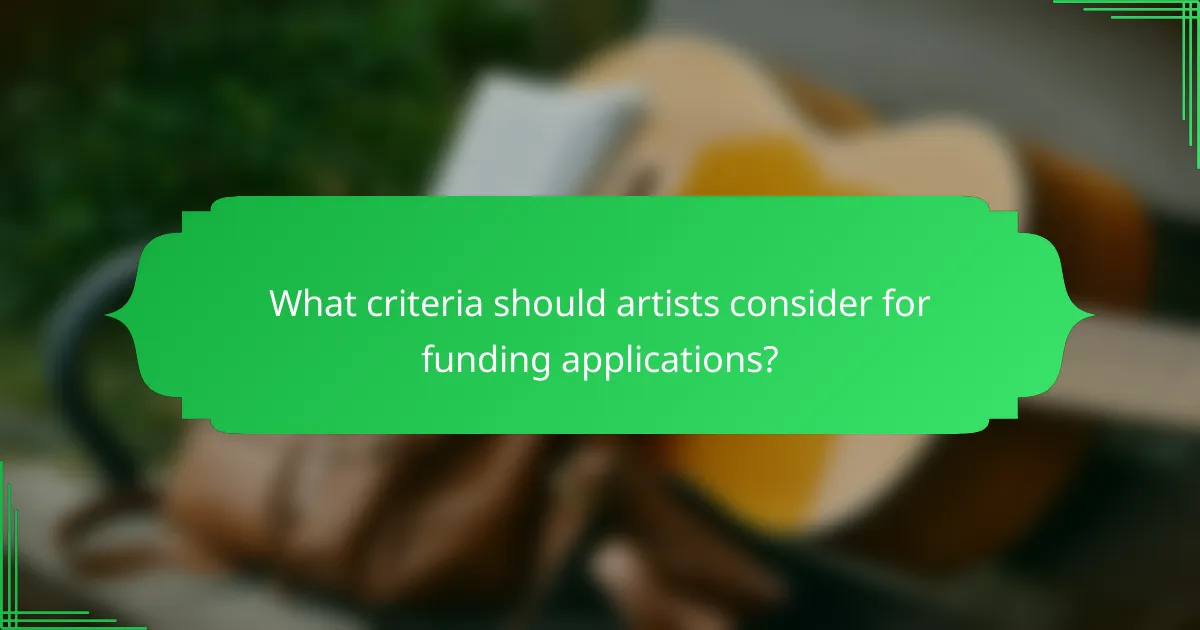
What criteria should artists consider for funding applications?
Artists should consider project feasibility, impact, budget, and financial planning when applying for funding. These criteria help ensure that the proposed project is realistic, financially viable, and aligns with the goals of potential funders.
Project feasibility and impact
Evaluating project feasibility involves assessing whether the artistic vision can be realistically executed within the given timeframe and resources. Consider factors such as available materials, venue accessibility, and the skills required to complete the project.
Impact refers to the potential effect of the project on the community or audience. Artists should articulate how their work will engage viewers, contribute to cultural dialogue, or address social issues. Clear examples of expected outcomes can strengthen the application.
Budget and financial planning
A detailed budget is crucial for funding applications, outlining all anticipated costs, including materials, labor, and marketing. Artists should aim for transparency and accuracy, providing a clear breakdown of expenses to demonstrate financial responsibility.
Financial planning should also include potential income sources, such as ticket sales, merchandise, or additional grants. Artists might consider creating a budget that shows a balance between projected income and expenses, ensuring that the project is sustainable and appealing to funders.
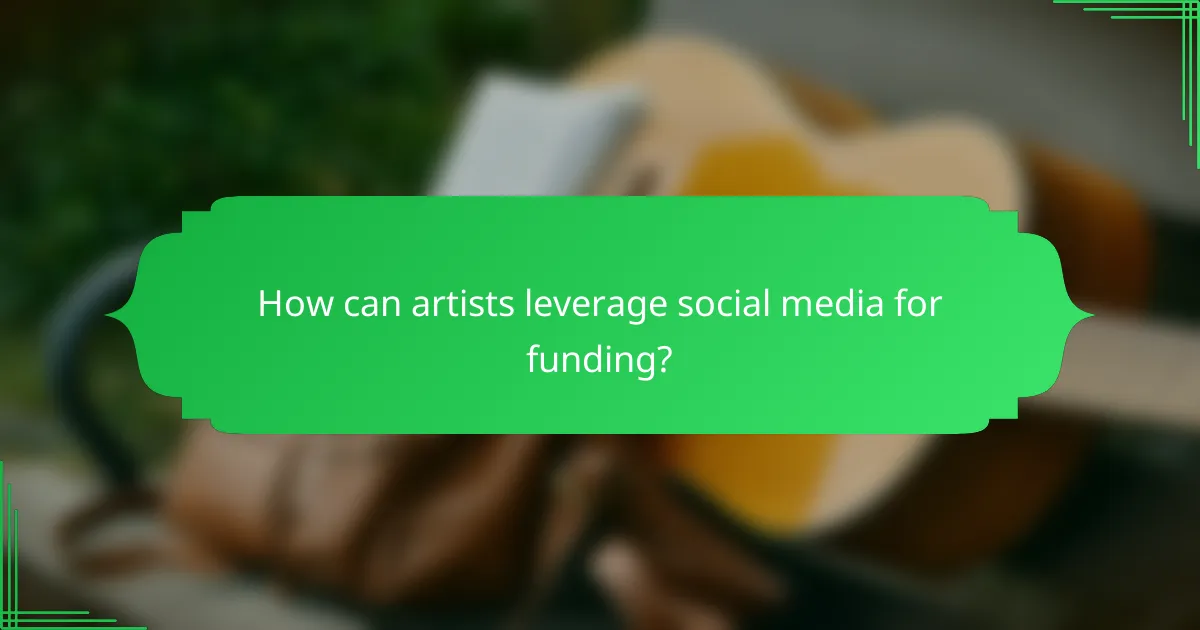
How can artists leverage social media for funding?
Artists can effectively use social media to secure funding by engaging with their audience and promoting crowdfunding campaigns. Platforms like Instagram, Facebook, and Twitter allow artists to showcase their work, connect with potential supporters, and drive traffic to their funding initiatives.
Building an engaged audience
To build an engaged audience, artists should consistently share high-quality content that resonates with their target demographic. This includes behind-the-scenes looks at their creative process, personal stories, and interactive posts that encourage audience participation.
Utilizing hashtags relevant to their art form can help artists reach a broader audience. Engaging with followers through comments and direct messages fosters a sense of community, making supporters more likely to contribute to funding efforts.
Promoting crowdfunding campaigns
When promoting crowdfunding campaigns, artists should create compelling narratives that explain their projects and funding needs. Clear visuals, such as videos and images, can enhance the appeal of the campaign and draw in potential backers.
Sharing updates throughout the campaign keeps the audience informed and engaged. Artists should consider offering incentives, such as exclusive content or merchandise, to encourage contributions. Regularly thanking supporters publicly can also strengthen relationships and encourage future funding efforts.
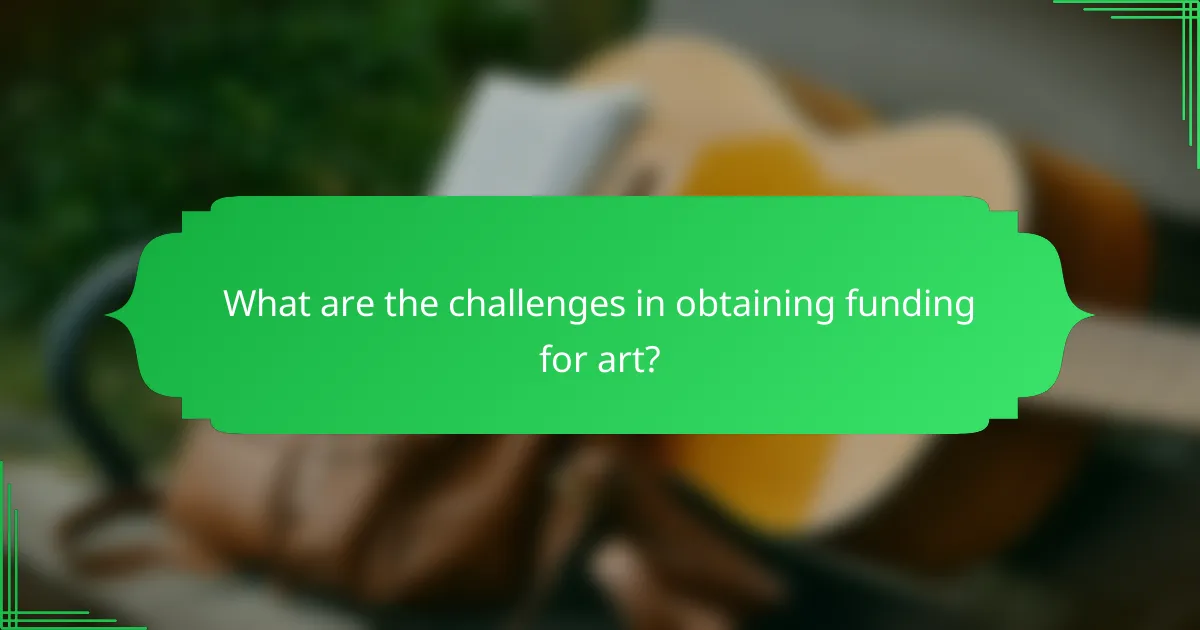
What are the challenges in obtaining funding for art?
Obtaining funding for art can be difficult due to various challenges, including intense competition for limited resources and the complexity of understanding grant requirements. Artists and organizations must navigate these hurdles to secure financial support for their projects.
Competition for limited resources
The art funding landscape is highly competitive, with many artists vying for a small pool of available grants and sponsorships. This competition can make it challenging for individual artists or smaller organizations to stand out and secure the necessary funding.
To improve chances of success, artists should focus on creating unique, compelling proposals that clearly articulate their vision and the impact of their work. Networking within the art community and building relationships with potential funders can also enhance visibility and opportunities.
Understanding grant requirements
Each grant or funding opportunity comes with its own set of requirements, which can vary significantly. Artists must carefully review eligibility criteria, application processes, and deadlines to ensure they meet all necessary conditions.
Common requirements may include detailed project descriptions, budgets, timelines, and examples of past work. It is advisable to create a checklist of these requirements for each grant application to avoid missing critical components that could lead to disqualification.
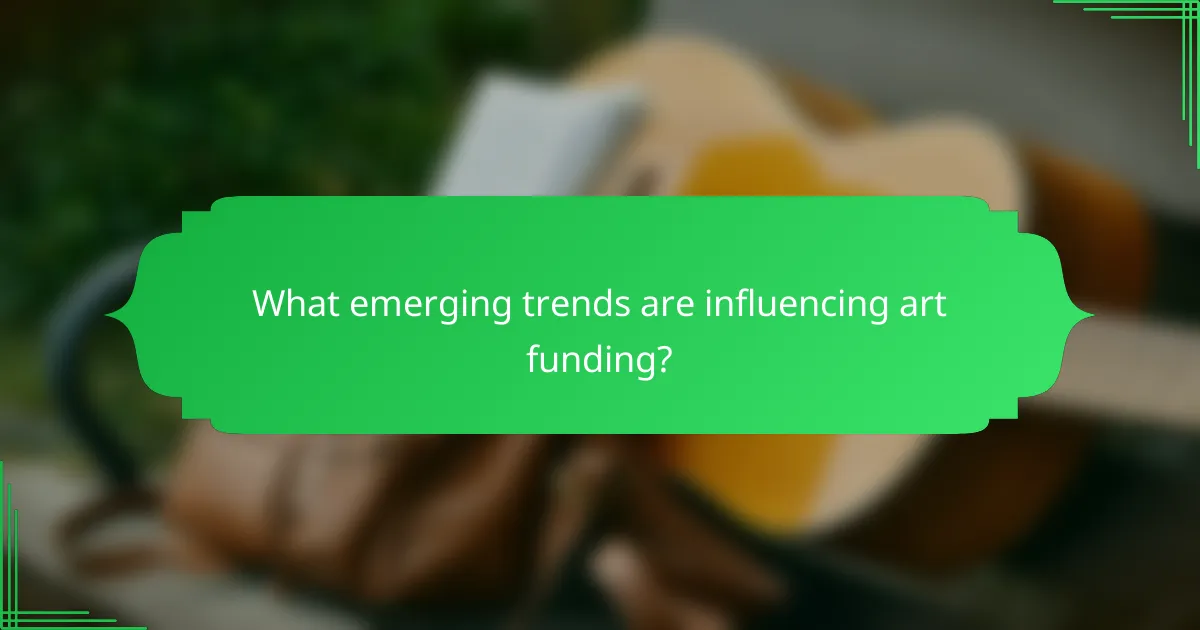
What emerging trends are influencing art funding?
Emerging trends in art funding reflect a shift towards innovative approaches that adapt to the evolving landscape of the art world. These trends include a growing emphasis on digital art and collaborative funding models that engage multiple stakeholders.
Increased focus on digital art funding
The rise of digital art has prompted funders to allocate more resources towards this medium. Digital art encompasses various forms, including NFTs, virtual reality, and interactive installations, which often require different funding strategies compared to traditional art forms.
Artists and organizations seeking funding for digital projects should consider platforms that specialize in this area, such as those offering grants specifically for digital innovation. Engaging with tech companies or digital art collectives can also provide additional funding opportunities.
Collaborative funding models
Collaborative funding models are becoming increasingly popular as artists and organizations pool resources to support projects. This approach can enhance the sustainability of art initiatives by sharing financial risks and leveraging diverse networks.
Examples of collaborative funding include joint grant applications, crowdfunding campaigns that involve multiple creators, and partnerships with local businesses. Artists should explore these options to maximize their funding potential while fostering community engagement.
